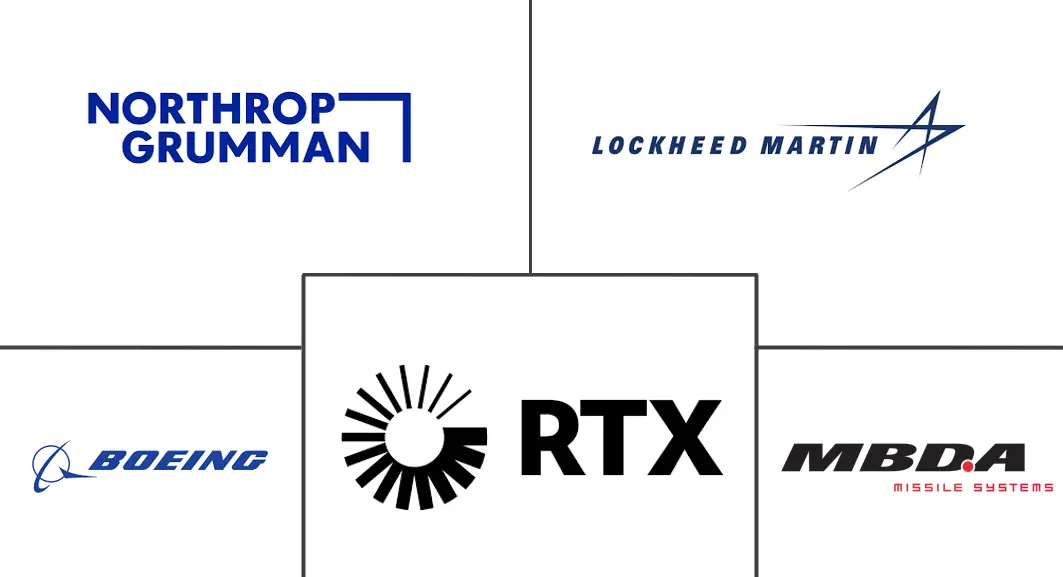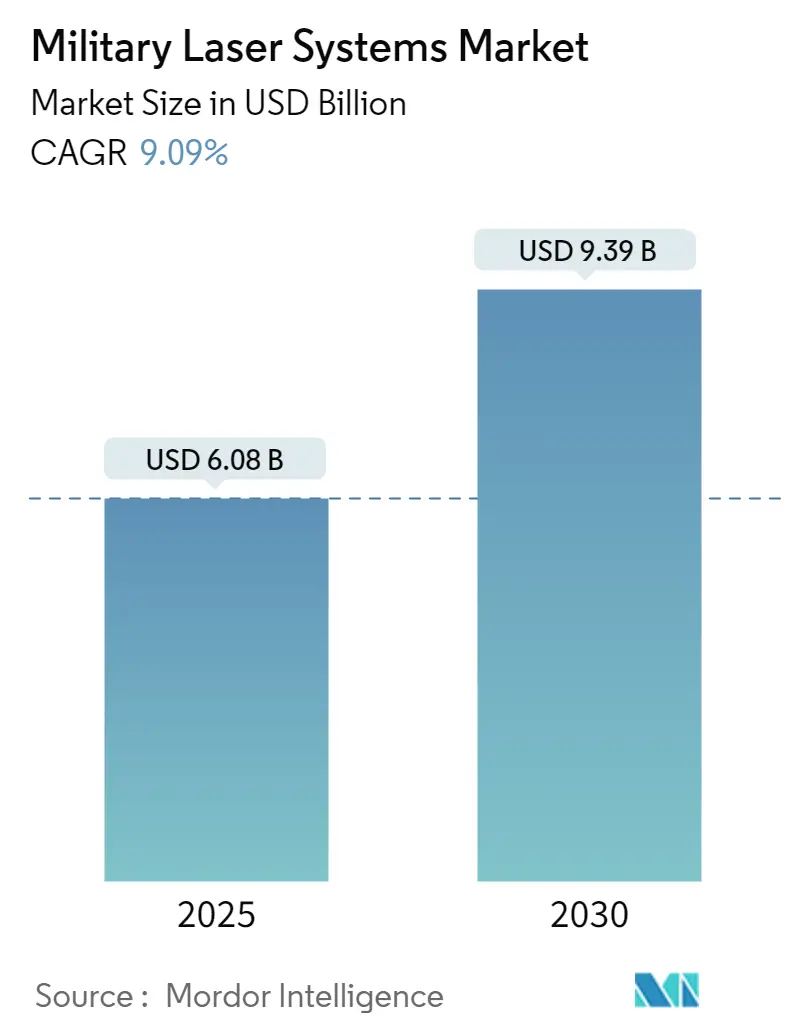
Military Laser Systems Market Analysis
The Military Laser Systems Market size is estimated at USD 6.08 billion in 2025, and is expected to reach USD 9.39 billion by 2030, at a CAGR of 9.09% during the forecast period (2025-2030).
Due to escalating geopolitical issues, military forces globally are deploying cutting-edge laser systems onboard with various platforms to support military personnel's combat and non-combat needs. The growing demand for such systems from the global armed forces for integration into multiple weapons propels the market for military laser systems. Adoption of such systems is also fueled by their inherent advantages, which include high accuracy, rapid traversal, and affordability.
However, the inherent capital-intensive nature of the defense electronics industry due to the high associated costs for R&D and procurement of the systems is expected to hinder the growth of the market during the forecast period. The advent of hypersonic weaponry is expected to profoundly affect the targeting technologies of the current generation of defense systems. Energy weapons also require superior cooling technologies to remain active for a longer duration without damaging the circuitry of the surrounding systems.
Military Laser Systems Market Trends
The Directed Energy Weapons Segment Projected to Exhibit the Highest CAGR During the Forecast Period
Directed energy weapons (DEWs) offer a more cost-effective, high-speed, highly accurate method of countering aerial threats than using a highly expensive missile to destroy moderate-level threats, like small drones. The existing DEWs are focused on defensive functions such as safeguarding critical facilities against missiles, drones, and boats. Defense firms and organizations are investing in R&D to expand the current applications of DEWs.
The directed energy weapons segment will surge in the future due to the arms race between the global military powerhouses. DEWs will be equipped with combat platforms and deployed with conventional weapons by 2025. The United States has gradually begun installing the laser defense weapon system HELIOS (High Energy Laser and Integrated Optical-Dazzler with Surveillance) on its destroyers. These systems will enhance defense against hypersonic projectiles that can evade the AEGIS missile defense system, strengthening the military's aerial defense capabilities.
In October 2023, Lockheed Martin Corporation received a contract to create and supply a maximum of four 300 kW-class laser weapon systems to the US Army's Indirect Fire Protection Capability-High Energy Laser (IFPC-HEL) prototype initiative. The IFPC-HEL system is a supplementary element within a multi-layered defense framework designed to safeguard soldiers against various threats, including unmanned aerial systems, rockets, artillery, mortars, and rotary and fixed-wing aircraft. Such developments are expected to propel the segment's growth during the forecast period.
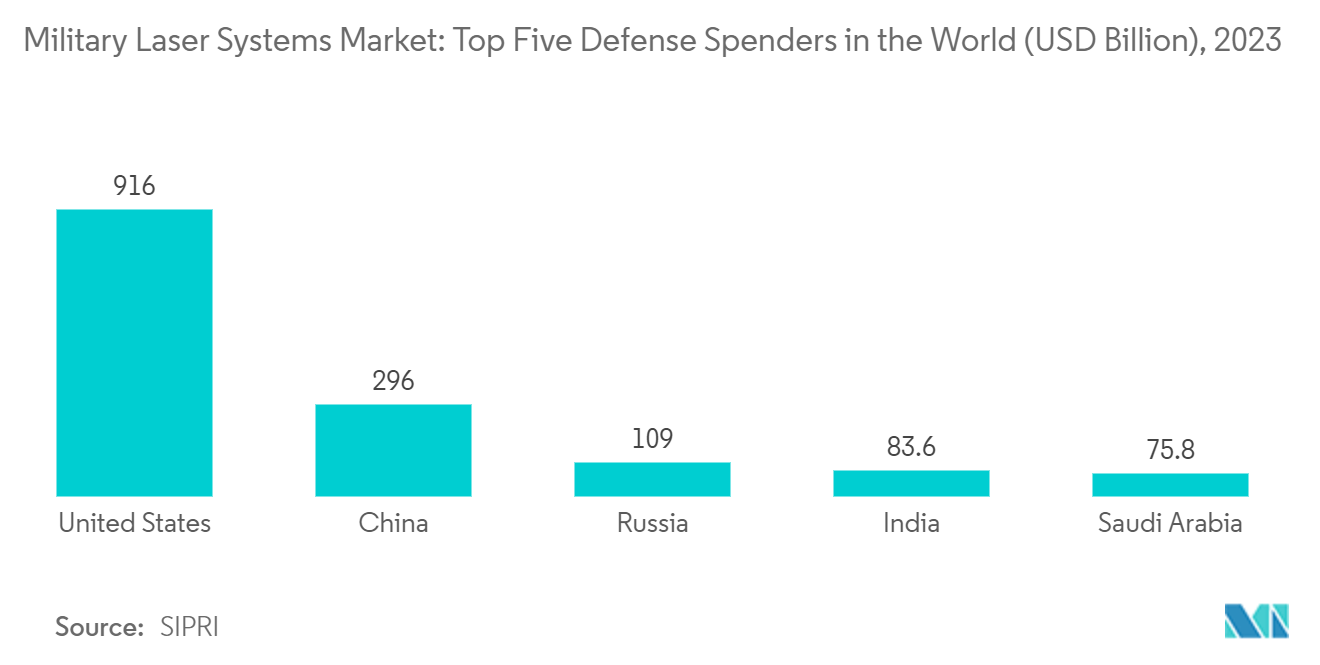
North America to Dominate the Market During the Forecast Period
North America is anticipated to show remarkable growth during the forecast period. The region's defense industry is mature and strongly supported by a robust R&D infrastructure. The US Department of Defense (DoD) requested around USD 669 million in FY2023 for unclassified research, testing, and evaluation and another USD 345 million for unclassified procurement.
In recent years, the United States has launched several programs to develop laser-based weapon technologies. The military aims to install laser-based weapon and defense systems on ground vehicles, ships, and aircraft. In September 2022, the US Army tested its first high-energy laser weapon from defense contractors Northrop Grumman Corporation and RTX Corporation. The US military is already using 100kW-150kW laser weapons and is developing more powerful 300kW laser weapons to counter supersonic cruise missiles. Such developments are expected to boost North America's market growth during the forecast period.
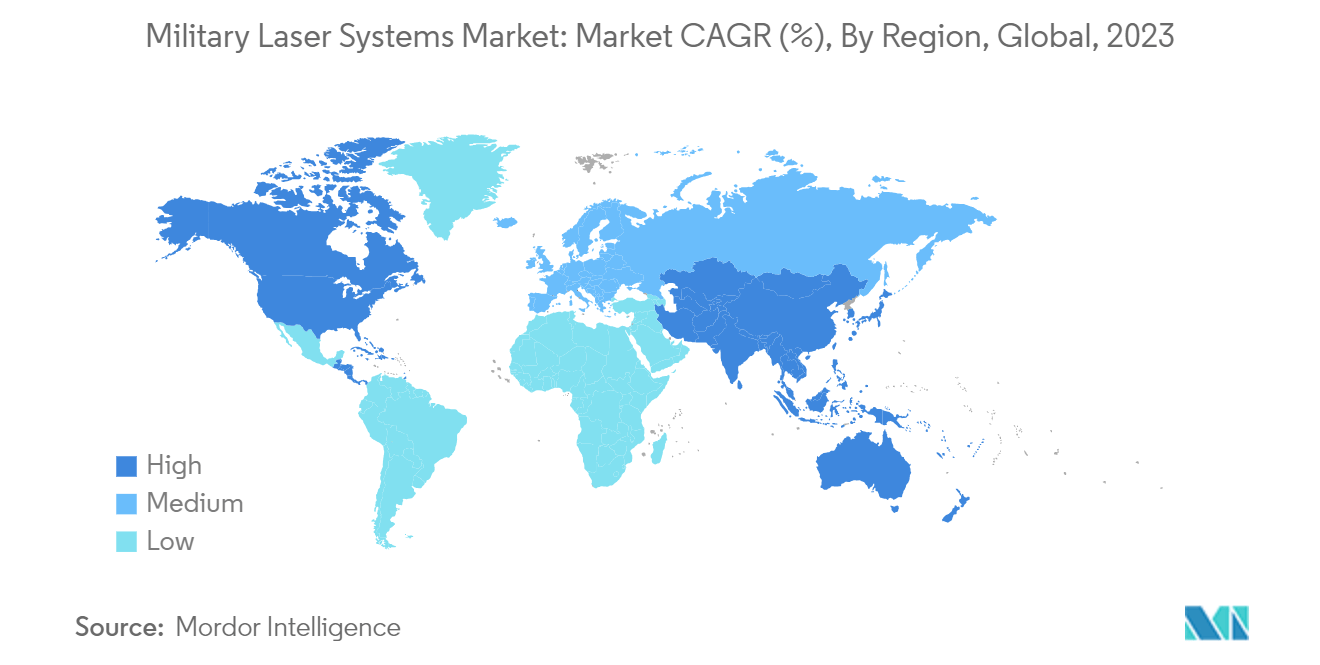
Military Laser Systems Industry Overview
The military laser systems market is semi-consolidated and marked by prominent players, including Lockheed Martin Corporation, MBDA, The Boeing Company, RTX Corporation, and Northrop Grumman Corporation. The growing adoption of military laser systems globally is accredited to growing collaborations and partnerships between various defense manufacturers.
Laser technologies are increasing in the military, with much scope for innovation. Players are developing several types of advanced laser systems to attract new customers. In this regard, in April 2022, Israel tested the Iron Beam, a new laser-based air defense system capable of destroying aerial threats like UAVs, missiles, and rockets, developed by Rafael Advanced Defence Systems.
Military Laser Systems Market Leaders
-
Lockheed Martin Corporation
-
The Boeing Company
-
Northrop Grumman Corporation
-
MBDA
-
RTX Corporation
- *Disclaimer: Major Players sorted in no particular order
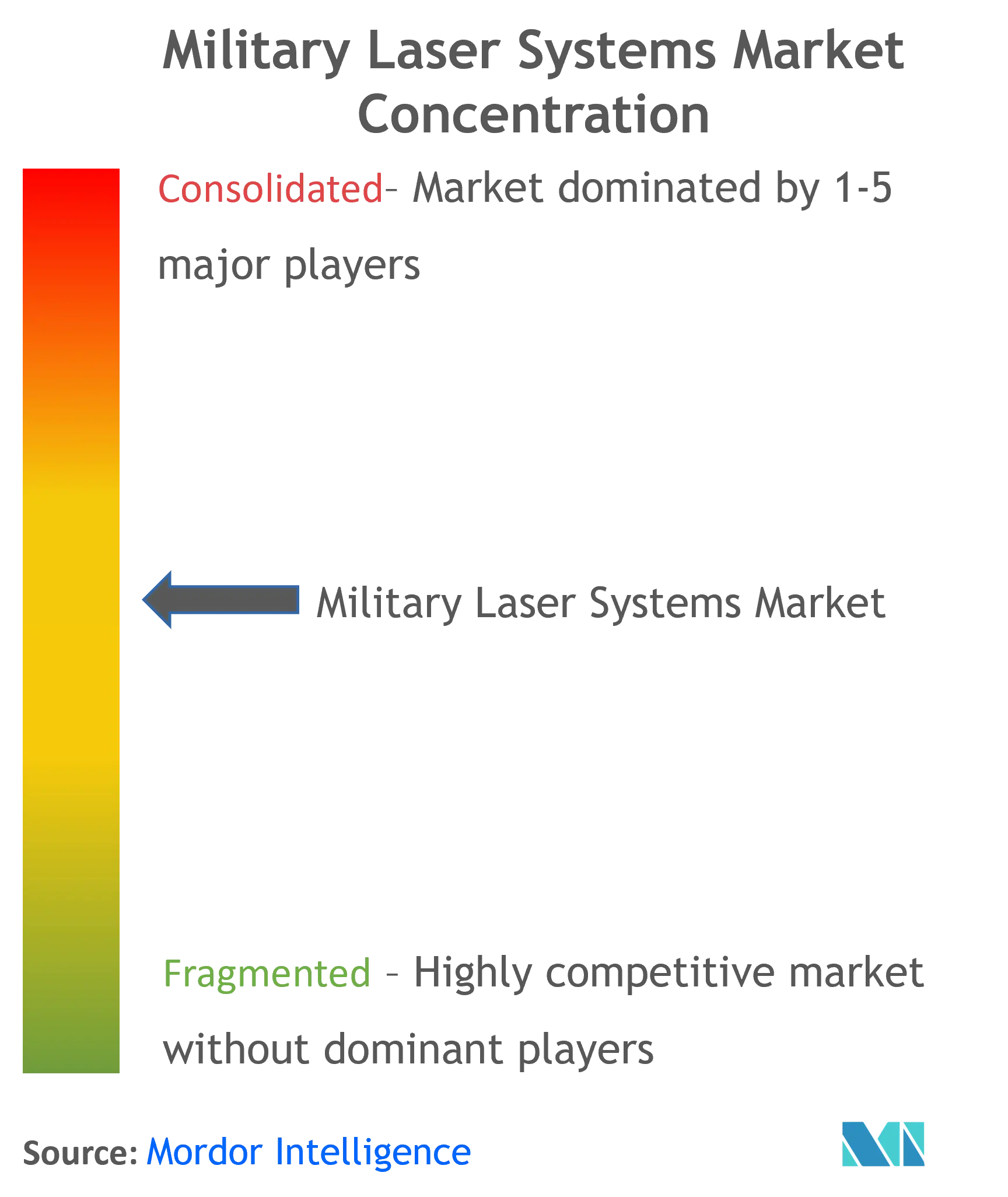
Military Laser Systems Market News
- May 2024: The US Army Space and Missile Defense Command (SMDC) granted BlueHalo a contract worth USD 95.4 million to advance Directed Energy (DE) prototype development within the framework of the Laser Technology Research Development and Optimization (LARDO) program under the Aviation & Missile Technology Consortium (AMTC).
- June 2023: RTX Corporation delivered the fourth combat-ready laser weapon to the US Air Force. The new palletized laser weapon was the first 10 KW laser built to US military specifications in a stand-alone configuration that can be moved and mounted anywhere needed.
Military Laser Systems Industry Segmentation
Military laser systems are direct diode sources or DPSS lasers with a rugged design that can withstand deployment's extensive shock and vibrations in harsh conditions. They are used in various applications, such as night vision equipment, targeting systems, distraction devices, and psychological warfare, to confuse the enemy.
The military laser systems market is segmented by technology, application, and geography. By technology, the market is segmented into solid-state lasers, gas lasers, and other technologies. The other technologies segment includes semiconductor, chemical, and dye lasers. By application, the market is segmented into directed energy weapons, guidance systems, laser sights, designators, and rangefinders, and other applications. The other applications segment includes offensive laser systems, distraction devices, and laser countermeasure systems. Also, the report covers the sizes and forecasts for the military laser systems market in major countries across different regions. For each segment, the market size is provided in terms of value (USD).
| Technology | Solid-state Lasers | ||
| Gas Lasers | |||
| Other Technologies | |||
| Application | Directed Energy Weapons | ||
| Guidance Systems | |||
| Laser Sights, Designators, and Rangefinders | |||
| Other Applications | |||
| Geography | North America | United States | |
| Canada | |||
| Europe | United Kingdom | ||
| Germany | |||
| France | |||
| Italy | |||
| Russia | |||
| Rest of Europe | |||
| Asia-Pacific | China | ||
| India | |||
| Japan | |||
| South Korea | |||
| Rest of Asia-Pacific | |||
| Latin America | Brazil | ||
| Rest of Latin America | |||
| Middle East and Africa | United Arab Emirates | ||
| Saudi Arabia | |||
| Israel | |||
| Rest of Middle East and Africa | |||
Military Laser Systems Market Research FAQs
How big is the Military Laser Systems Market?
The Military Laser Systems Market size is expected to reach USD 6.08 billion in 2025 and grow at a CAGR of 9.09% to reach USD 9.39 billion by 2030.
What is the current Military Laser Systems Market size?
In 2025, the Military Laser Systems Market size is expected to reach USD 6.08 billion.
Who are the key players in Military Laser Systems Market?
Lockheed Martin Corporation, The Boeing Company, Northrop Grumman Corporation, MBDA and RTX Corporation are the major companies operating in the Military Laser Systems Market.
Which is the fastest growing region in Military Laser Systems Market?
Asia Pacific is estimated to grow at the highest CAGR over the forecast period (2025-2030).
Which region has the biggest share in Military Laser Systems Market?
In 2025, the North America accounts for the largest market share in Military Laser Systems Market.
What years does this Military Laser Systems Market cover, and what was the market size in 2024?
In 2024, the Military Laser Systems Market size was estimated at USD 5.53 billion. The report covers the Military Laser Systems Market historical market size for years: 2019, 2020, 2021, 2022, 2023 and 2024. The report also forecasts the Military Laser Systems Market size for years: 2025, 2026, 2027, 2028, 2029 and 2030.
Our Best Selling Reports
Military Laser Systems Industry Report
Statistics for the 2025 Military Laser Systems market share, size and revenue growth rate, created by Mordor Intelligence™ Industry Reports. Military Laser Systems analysis includes a market forecast outlook for 2025 to 2030 and historical overview. Get a sample of this industry analysis as a free report PDF download.

